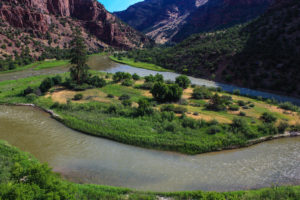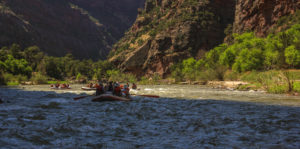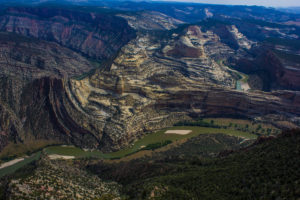
Dinosaur National Monument offers scenery, adventure. Photo from Mitch Stevens.
Today we have a guest post from my friend Mitch Stevens, who leads hikes and adventure trips throughout the Southwest for the Sierra Club and as founder of Southwest Discoveries.
Mitch recounts a recent rafting trip along Utah’s Green River through spectacular Dinosaur National Monument. This family-oriented trip is perfect for multi-generational travel with grandkids. (And what kid doesn’t like dinosaurs?).
By Mitch Stevens
We hiked through a narrow defile carved through red sandstone. The foliage in the canyon was lush: Boxelder, grapevines, Ponderosa pine and Douglas fir trees all thrived in the moist environment. A clear stream murmured near the trail, contributing to the serenity.
We rounded a bend in the canyon and heard falling water in the distance. Soon our group came upon the source of the sound, a breathtaking waterfall tumbling 200 feet down a sheer cliff into a pool below. It was enchanting, the perfect place to be on a summer afternoon along an amazing river canyon.
Welcome to rafting in Utah’s Dinosaur National Monument, where you will experience some of the most remarkable wilderness lands in the world.
The day before we splashed through class two and three rapids along Utah’s spectacular Green River.
The river starts its journey in the Wind River Mountains of Wyoming, high in the Rocky Mountains, and cuts through the immense Uinta mountain range.
Forced into constricted channels, drops in the waterway create these fun rapids. Multi-colored canyon walls soar above the watercourse and tell the geologic story of when dinosaurs ruled the earth.
We observed Native American rock art, spotted bighorn sheep on the banks and cliffs, explored slot canyons and floated the Green in peaceful sublimity.
Our chief mode of transportation on this journey were 18-foot oar-powered rafts, each led by an experienced and knowledgeable river guide. All the participants freely switched boats throughout the trip.
In addition to the oar boats, some of us shot the rapids and floated calm stretches in inflatable kayaks, a fun and challenging way to become more acquainted with the river.

Rafting the Green is an ideal family adventure.
Each night we made camp at a different location. Guests set up their own tents and then had time for other activities while the guides began dinner preparation. The cuisine was delicious and sumptuous, and the guides doubled as gourmet chefs.
Gates of Lordore
Shortly after we began our expedition the first day, we entered the dramatic “Gates of Lodore,” the gateway into Lodore Canyon. It’s a dark red chasm composed of Precambrian rock, cut through the wild canyon lands of eastern Utah.
The canyon was named by Andrew Hall, a member of John Wesley Powell’s expedition. Powell was the first white man to explore the entire length of the Green and Colorado River watershed.
They started their journey in Wyoming and floated the Green River through Dinosaur National Monument, Gray and Desolation Canyons, Glen Canyon, Grand Canyon and culminated their exploration along the Colorado near Yuma Arizona.
On subsequent days, we experienced whitewater such as Harp Falls, Triplet Falls, and the stimulating “Hells Half Mile.” We passed through Echo Park, where the Yampa (the last undammed tributary of the Colorado) joins the Green River from the east. The river here wraps around impressive Steamboat Rock, which juts up more than 1,000 feet.
Conserving the Green

Harper’s Corner along the Green.
Below Echo park we drifted past the place where the Bureau of Reclamation was set to build a huge dam in the 1950s. This would have plugged up the Green and created a reservoir, destroying the wilderness aspects of this special place.
Along with others, the Sierra Club’s David Brower, the father of the modern environmental movement, helped stop this disastrous project — making this event a cornerstone of conservation in the West. But it came at a big price: losing Glen Canyon downstream, flooding what many people regarded as the most magnificent canyon in the country.
But Dinosaur National Monument, created in 1915 by President Woodrow Wilson, still faces environmental challenges.
The Green River is consistently named as one of America’s “most endangered rivers” by national conservation groups. And politicians in Utah and Washington D.C. are shrinking huge chunks of Utah’s beloved Grand Staircase Escalante and Bear Ears National Monuments.
World Famous Dinosaur Quarry
On the final day we traveled through Whirlpool Canyon, Island Park, and Rainbow Park to our take-out location below Split Mountain. This is near the quarry that gives Dinosaur National Monument its name.
The quarry is a worthwhile destination in its own right. Visitors can view nearly 1,500 dinosaur bones, making this site one of the premier dinosaur fossil areas on the planet.
As David Brower put it, “Let the mountains talk, let the river run. Once more, and forever.” Dinosaur National Monument not only showcases some of the most awe-inspiring landscapes on the planet but speaks of activism and conservation, making the environmental movement a uniquely quintessential and vital American idea.
Note to Readers:
To sign up for the 2018 Sierra Club Dinosaur National Monument Family Rafting Trip, register here. There are still some openings for this trip!












One Response to Rafting in Dinosaur National Monument